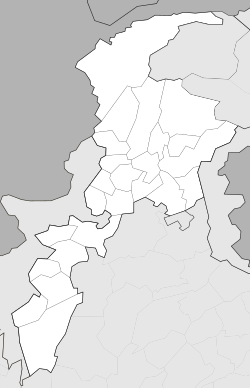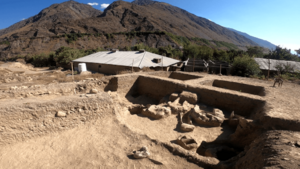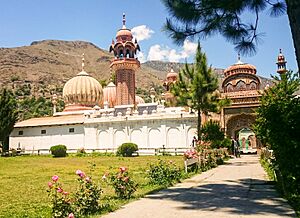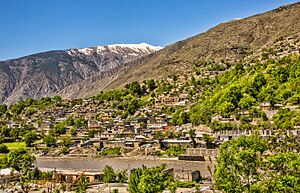Chitral facts for kids
Quick facts for kids
Chitral
|
|
|---|---|
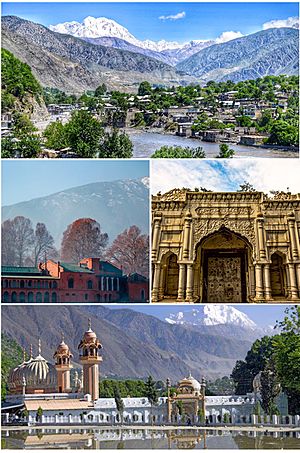
Clockwise from top:
|
|
| Nickname(s):
Qāshqār
|
|
| Country | |
| Province | |
| District | Lower Chitral |
| Established | 1885 |
| Founded by | British government |
| Named for | Field |
| Government | |
| • Type | Municipal Corporation |
| • Body | District Government |
| Area | |
| • Total | 14,850 km2 (5,730 sq mi) |
| Elevation | 1,494 m (4,902 ft) |
| Population
(2017)
|
|
| • Total | 49,780 |
| • Density | 3.3522/km2 (8.682/sq mi) |
| Demonym(s) | Chitralis |
| Languages | |
| • Official | Urdu |
| • Regional | Chitrali |
| Time zone | UTC+5:00 (Pakistan Standard Time) |
| Zip Code |
17200
|
| Area code(s) | 0943 |
| Vehicle registration | CL |
Chitral (Khowar: ݯھیترار, romanized: ćhitrār, lit. 'field') is a city situated on the Chitral River in northern area of Khyber Pakhtunkhwa. It serves as the capital of the Lower Chitral District, and was previously the capital of Chitral District, and before that the capital of Chitral princely state. The region was encompassed into West Pakistan between the years 1969 and 1972. It has a population of 49,780 per the 2017 census.
Contents
History
Nothing definitive is recorded about the town’s first settlers. In the 3rd century AD, Kanishka, the Buddhist ruler of the Kushan empire, occupied Chitral. In the 4th century AD, the Chinese overran the valley. Raees rule over Chitral began in 1320 and came to an end in the 15th century. From 1571 onwards Chitral was the capital of the princely state of Chitral under the rule of the Katur Dynasty.
Ancient era
The existence of the Gandharan Grave Culture in Chitral, found in various grave sites scattered over its valleys gives an insightful knowledge of its inhabitants following the Indo-Aryan migrations, after the decline of Indus Valley civilization. The Gankorineotek cemetery in Singoor is home to several ancient burial sites, dating back to the Vedic period.
The area which now forms Chitral was reportedly conquered by the Persian Achaemenids and was a part of one of their easternmost satraps. In the third century CE, Kanishka, the Buddhist ruler of the Kushan empire, occupied Chitral. Under the Kushans, many Buddhist monuments were built around the area, mainly Buddhist stupas and monasteries. The Kushans also patronised Buddhist art; some of the finest examples of the image of Buddha were produced in the region under the Kushan rule.
Kator era
From 1571 to 1969, Chitral was the dominion of the Kator Dynasty. The British and Sikh garrison suffered a siege by the Chitralis, possibly aided by Afghan forces, in 1895. The garrison was relieved after six weeks, and the British installed the young Shuja ul-Mulk as Mehtar ("ruler"). He ruled for the next 41 years.
Accession to Pakistan
In 1947, following the division of the British colony of India, princely states were offered the choice to either remain independent or to choose one of the two new dominions. Initially, Chitral chose to remain an independent Monarchy. Later, the Mehtar of Chitral, who was a friend of Quaid E Azam Mohammad Ali Jinnah, acceded to Pakistan and thus Chitral became one of the princely states of Pakistan. Through 1969 to 1972, it was fully integrated into Pakistan as the administrative district of Chitral.
Role in the First Kashmir War
Chitral played an instrumental role in the 1947–1948 first Kashmir war. Immediately after acceding to Pakistan, Mehtar Muzaffar ul-Mulk proclaimed Jihad to 'liberate' Kashmir from the Dogras. At this point, the Gilgit scouts were retreating and the Dogra forces had made gains in the Burzil pass. Under these circumstances, the Chitral scouts relieved the Gilgit scouts in Domel and Kamri sectors whilst the Chitral Bodyguard force went towards Skardu. The Chitral bodyguards under the leadership of a Chitral Prince laid one of the longest sieges in military history which ended with the fall of Skardu, the surrender of the Dogras, and the capture of Baltistan. During this time, the Chitral scouts assimilated with the Gilgit scouts and went on towards taking the Kargil pass.
Geography
The city has an average elevation of 1,500 m (4,921 ft).
Climate
In contrast to more southerly valleys of Khyber Pakhtunkhwa, Chitral has a dry Mediterranean climate (Köppen Csa) with almost no rainfall during the very hot summers. Precipitation occurs mainly from spring thunderstorms brought about by western frontal systems. In the winter the nighttime temperature occasionally drops to −10 °C. Winter snowfall in the town can be quite heavy with an accumulation of up to 60 cm being quite common, at higher elevations snowfall can reach as high as 20 metres (70 ft).
| Climate data for Chitral, Khyber Pakhtunkhwa | |||||||||||||
|---|---|---|---|---|---|---|---|---|---|---|---|---|---|
| Month | Jan | Feb | Mar | Apr | May | Jun | Jul | Aug | Sep | Oct | Nov | Dec | Year |
| Record high °C (°F) | 16.9 (62.4) |
21.0 (69.8) |
28.0 (82.4) |
34.3 (93.7) |
38.3 (100.9) |
42.5 (108.5) |
44.4 (111.9) |
42.2 (108.0) |
39.8 (103.6) |
34.4 (93.9) |
27.0 (80.6) |
20.7 (69.3) |
44.4 (111.9) |
| Mean daily maximum °C (°F) | 8.8 (47.8) |
9.9 (49.8) |
15.1 (59.2) |
22.5 (72.5) |
28.2 (82.8) |
34.4 (93.9) |
35.9 (96.6) |
34.4 (93.9) |
31.1 (88.0) |
25.1 (77.2) |
18.7 (65.7) |
11.6 (52.9) |
23.0 (73.4) |
| Daily mean °C (°F) | 4.1 (39.4) |
5.3 (41.5) |
9.6 (49.3) |
15.5 (59.9) |
20.3 (68.5) |
26.1 (79.0) |
28.0 (82.4) |
26.5 (79.7) |
22.1 (71.8) |
16.2 (61.2) |
10.8 (51.4) |
5.9 (42.6) |
15.9 (60.6) |
| Mean daily minimum °C (°F) | −0.6 (30.9) |
0.6 (33.1) |
4.2 (39.6) |
8.5 (47.3) |
12.5 (54.5) |
17.8 (64.0) |
20.2 (68.4) |
18.7 (65.7) |
13.1 (55.6) |
7.2 (45.0) |
2.9 (37.2) |
0.2 (32.4) |
8.8 (47.8) |
| Record low °C (°F) | −11.0 (12.2) |
−11.0 (12.2) |
−3.7 (25.3) |
0.0 (32.0) |
4.4 (39.9) |
8.9 (48.0) |
11.1 (52.0) |
10.6 (51.1) |
5.6 (42.1) |
1.1 (34.0) |
−3.0 (26.6) |
−12.2 (10.0) |
−12.2 (10.0) |
| Average precipitation mm (inches) | 38.4 (1.51) |
63.8 (2.51) |
97.3 (3.83) |
71.7 (2.82) |
43.9 (1.73) |
5.1 (0.20) |
4.9 (0.19) |
8.0 (0.31) |
7.3 (0.29) |
15.6 (0.61) |
20.4 (0.80) |
38.5 (1.52) |
414.9 (16.32) |
| Mean monthly sunshine hours | 134.0 | 133.7 | 150.4 | 188.6 | 247.0 | 286.3 | 285.4 | 258.6 | 231.0 | 214.0 | 182.5 | 130.7 | 2,442.2 |
| Source: NOAA (1971-1990) | |||||||||||||
Demographics
Urdu is the official language of the city. According to the 1981 census, Khowar is the main language and is spoken by 98% of the population. Kalasha is also spoken by a small population.
As per the 2017 census, Chitral has a population of 49,780.
Historical demographics
| Religion | Population (1901) | Percentage (1901) |
|---|---|---|
| Islam |
3,452 | 42.47% |
| Hinduism |
2,709 | 33.33% |
| Sikhism |
1,826 | 22.47% |
| Total | 8,128 | 100% |
Educational institutions
- University of Chitral
Notable people
- Falak Naz Chitrali (Member of Senate of Pakistan)
- Wazir Zada (Member of Provincial Assembly of KPK)
- Abdul Akbar Chitrali (Member of National Assembly of National Assembly of Pakistan)
See also
 In Spanish: Chitral para niños
In Spanish: Chitral para niños


